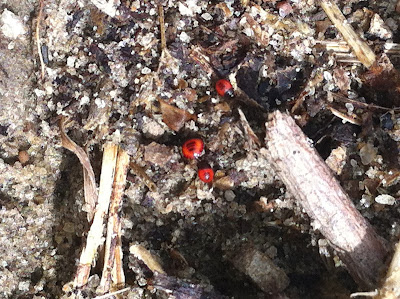Several reports have been received in recent days concerning the white margined burrower bug in seedling cotton. These observations have come from Geneva County in the south to as far north as Shelby county (near Birmingham). So far, no damage has been connected to this insect. Grasshoppers are also present in most fields and the stand losses have come from grasshoppers. The burrower bug has sucking mouth parts and does not chew into the stem as grasshoppers do with chewing mouth parts. The burrower bug is usually not an economic pest on either cotton or soybeans. Therefore, a dedicated spray for this insect should not be necessary. Seed treatments (Cruiser, Gaucho) do a good job of controlling burrower bugs once they feed on the seedling plants. Most all insecticides used for thrips or grasshoppers should also control these bugs. Immature burrower bugs are red, or red with black markings on their bodies. A certain stage of this bug requires the weed “henbit” as a food source. They move to cultivated crops once the henbit has been burned down prior to planting. This species is not the same one that attacks peanuts later in the season.
Tuesday, April 24, 2012
Friday, April 13, 2012
Immature Grasshoppers in Winter Cover Wheat
Cotton planting is underway in a significant way in some south Alabama counties. A question was received today from that area about what to do with the grasshoppers in winter cover wheat that is currently being burned down prior to planting cotton. Immature grasshoppers are present at thousands per acre in the wheat. My recommendation would be to control these grasshoppers at the same time wheat is being burned down or prior to the time the cotton begins to emerge. They pose a significant risk to stands if allowed to remain in fields. Based on our research of several years ago, immature grasshoppers can be easily controlled with a low-to-mid range rate of most any insecticide labeled for cotton. The pyrethroids do an excellent job and are very economical. Adding 1 oz. of Dimilin per acre to the mix would provide residual control of immatures for weeks down the road. Since we are still early in the spring, there could be some additional migration into fields from hedgerows and field borders. The problem with waiting until later to make an application is eventually these immature grasshoppers will become adults, which is much more difficult to control.
Wednesday, April 4, 2012
True Armyworms Spotted in Early April
True Armyworms were reported on April 2nd feeding on rye near the Wiregrass Research Station (near the Headland, AL airport), in Henry County. This insect had previously been reported from the Coastal Bend of Texas to South Georgia and as far north as Kentucky. The larvae feed mostly at night and may not be found in daylight hours until digging into the soil surface debris. The larvae vary from green to brown with lighter stripes on their sides and back. In some ways they look similar to Fall armyworms.
These caterpillars can cause extensive damage below the crop canopy before they are detected. Controls are suggested when 4 to 5 larvae per square foot are found and feeding is heavy on the lower leaves. It is important to protect the flag leaf.
These caterpillars can cause extensive damage below the crop canopy before they are detected. Controls are suggested when 4 to 5 larvae per square foot are found and feeding is heavy on the lower leaves. It is important to protect the flag leaf.
Most all insecticides labeled for small grains will provide adequate control. They are not as hard to kill as fall armyworms in cotton. However, good coverage is important, especially when making applications by air.
Subscribe to:
Posts (Atom)
